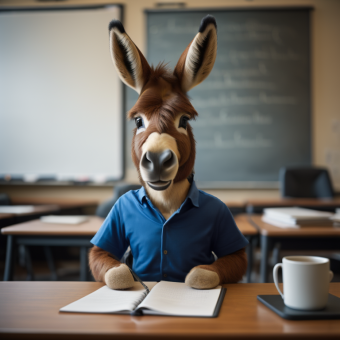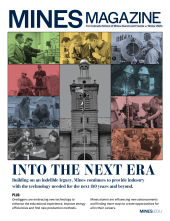How Colorado School of Mines is approaching the integration of generative AI into the classroom
Guidelines developed by Mines faculty, administrators and students offer three suggested paths for AI use

This image was generated with AI using Imagine Web and edited using generative fill in Adobe Photoshop.

By Emilie Rusch, Special to Mines Magazine
Picture a campus where the timeless traditions of Mines seamlessly blend with the latest advancements in technology—welcome to the new era at Colorado School of Mines, where generative AI is shaping the future of education.
Sound like a story you might want to read? The first sentence of this article was actually written by ChatGPT 3.5, the free version of the generative artificial intelligence chatbot that has taken the world by storm since it was released by OpenAI in November 2022.
The prompt we gave the large language model (LLM)-driven tool was simple: “Give me four options for the first sentence of a magazine article about how generative AI is being used at Colorado School of Mines. The readers of the magazine are alumni of Colorado School of Mines.”
This was just our favorite of the four options, but the power of the popular generative AI (GenAI) tool can be both awe-inspiring and unsettling.
That power has also prompted conversations across higher education about how to address GenAI use in the classroom—and a wave of headlines prophesying the end of education as we know it amid a tsunami of GenAI-fueled cheating.
At Mines, those conversations began in earnest in summer 2023, when the Office of Academic Affairs convened a group of faculty members, administrators and students to determine a path forward. The results of those conversations are the “Guidelines for Using Generative Artificial Intelligence at Mines,” released to campus in August 2023.
The guidelines are just that—guidelines, not requirements—that offer Mines instructors three suggested paths for the use of GenAI in their classrooms. Faculty can generally permit the use of GenAI tools, generally forbid their use or permit their use for certain purposes on certain assignments but
not others.
At the heart of the guidelines is what the committee calls the TEACH approach: rather than homing in on cheating only, faculty should put their focus on building Trust and community with students; interrogating the Ethics of GenAI; ensuring equitable Access to GenAI; explicitly Communicating expectations and relevance of course tasks; and (re)designing assignments to center the Human in learning by tapping into student motivation, iteration, agency, lived experience and creativity.
“All of this is about AI, but it’s also not about AI,” said Carter Moulton, faculty developer at the Trefny Center for Innovative Instruction. “It’s about practices that support students and learning and build trust and clear expectations.”
That trust-centered approach was informed by a review of best practices in pedagogy and how other universities are tackling the issue—as well as data on how Mines students are actually using these tools.
Over the past year, C. Estelle Smith, assistant professor of computer science, has surveyed Mines students both in the Computer Science Department and across the university on their use of ChatGPT and other GenAI tools. More than 600 students responded to the university-wide survey, and the runaway No. 1 reason why Mines students use GenAI? Concept exploration, Smith said.
“That hadn’t even occurred to me to use ChatGPT that way: ‘Tell me about this thing and now tell me about it from a different perspective or about another subdetail you just mentioned,’” said Smith, an expert in human-computer interaction. “That wasn’t possible in the past. You only had access to what your instructor says during class or during office hours. This radically increases access to information. You can get really good information on topics that are both covered in class and not covered in class. It triggers curiosity.”
The survey data also reinforced what faculty already knew about Mines students: By and large, they really care about their learning.
“ChatGPT use really depends on people’s motivations,” Smith said. “If you’re motivated to cheat, you’re going to find a way to do that, and ChatGPT is going to make that easier. If you’re motivated to learn, then ChatGPT is something you’re going to use to improve the quality of that learning.”
In her own classroom, Smith allows students to use GenAI tools however they want as long as they cite it in their work. The assessments for her Fall 2023 graduate seminar, though, were designed in a way that made it almost harder for students to use ChatGPT than to just do the work on their own.
Personally, Smith has used the image generator DALL-E for her lecture slides to create conversation-provoking images. ChatGPT can also be helpful when you’re writing a paper about a certain topic and need supporting examples outside your area of expertise—so long as you always verify the answers the chatbot provides, she said.
“One of the challenges with ChatGPT is that anyone can use it and it creates meaningful human utterances—without any instruction manual required. With other tools, you are not able to use them, period, unless you have domain knowledge of the structured ways you have to write code to get something meaningful—otherwise you’ll just get errors,” Smith said. “This is a new paradigm—you can say whatever you want and you’ll get a response that looks meaningful. But we know it makes things up—ChatGPT makes up the most likely response. That’s what it does.”
And that’s where Mines has an important role to play, said Deb Jordan, director of the Trefny Center.
“In industry, workers are going to be using GenAI—industry is already adopting the technology like crazy,” Jordan said. “We can either help students become proficient in using this tool—and using it for good—or we can not work with them at all and then they’re going to be behind when they go out and get jobs.”
“The nuances of being literate in GenAI, including critiquing outputs and ethics and understanding when and when not to use these tools—all those considerations are going to be what sets Mines students apart,” Moulton added. “We want our students to develop that nuanced understanding so they can be leaders in the workplace and as citizens. Here at Mines, we lean into new things together and learn from one another as a community.”




